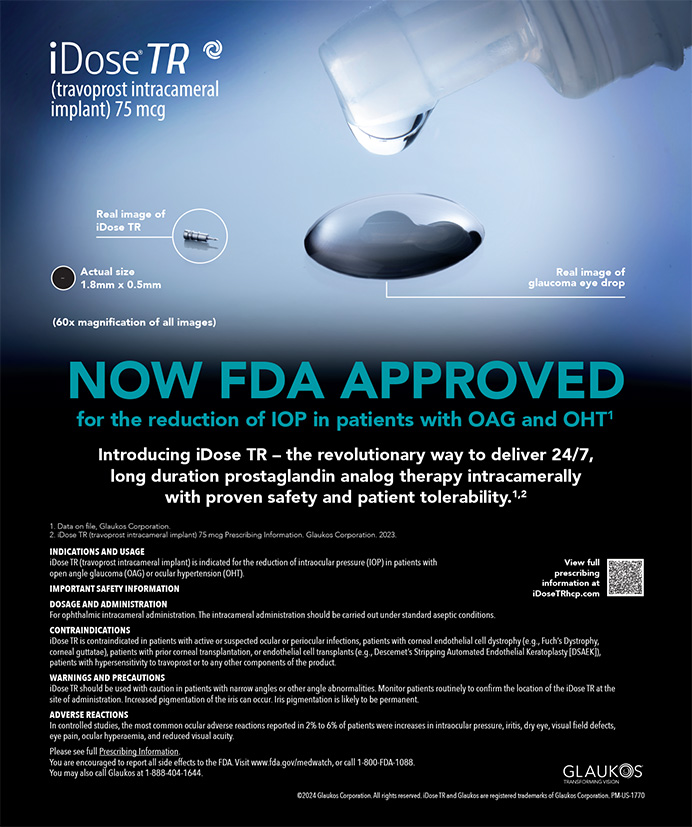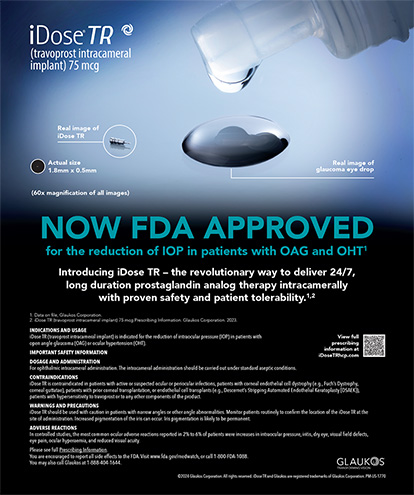We developed two postoperative strategies by which to accelerate patients' visual recovery after PRK or LASEK. In our experience, patients also felt less anxious and experienced greater satisfaction with their surgical outcomes.
STRATEGY No. 1. myopic THERAPEUTIC SOFT CONTACT LENS
We evaluated 36 eyes with myopia (range, 9.25-1.50 D). In addition to measuring patients' visual acuity after surface ablation, we refracted patients 1 day, 1 and 2 weeks, and 1 month after surgery to determine their refractive error in the early postoperative period when eyes were targeted for plano. The average amount of myopia on the first postoperative day with a plano therapeutic soft contact lens (Acuvue Oasys; Johnson & Johnson) was -1.18 ±0.82 D. When the soft lens was removed 1 week later, the average amount of myopia was -1.25 D.1
In response to these findings, we began placing a -1.25 D therapeutic soft contact lens on one of the patients' eyes and a plano soft lens on the other (to leave this eye slightly myopic for near vision). We found that the eye with the -1.25 D soft lens had better distance vision for the first postoperative week than the other eye (20/30 vs 20/45), which functioned better at near. This approach temporarily gives patients monovision and a large depth of focus binocularly. (For younger patients, we recommend correcting both eyes for distance with bilateral 1.25 D lenses.) The technique also speeds up patients' visual recovery and reduces their anxiety during the first 2 weeks after surgery.
We remove patients' contact lenses at the first week's visit. If the patient's visual acuity is 20/40 or less with more than 0.75 D of myopia, we insert a new myopic bandage soft contact lens that matches the spherical equivalent of his or her manifest refraction to provide more functional distance vision during the second week of recovery. We remove this lens after the second week's visit when the mean postoperative refraction has returned almost to plano (mean spherical equivalent, -0.27 D), which is the target of our treatment.
We believe that myopia occurs in the early postoperative period because an immediate swelling of the central cornea causes the cornea to steepen centrally. Ruberti et al demonstrated in a rabbit model of corneal perfusion that the central cornea swells rapidly when the corneal epithelium is removed.2 We have noted similar central swelling with central epithelial removal in our patients.3 This swelling is temporary and occurs during the first 2 postoperative weeks as the cornea re-epithelializes and inflammatory mediators diminish with healing.
STRATEGY No. 2. MINI PRK
Concept
Based on the concept of anatomic customization,1 the
LASIK flap's diameter, shape, and thickness should be
designed to complement the excimer laser's ablation.4
Laser ablation with large, deep, peripheral transition
zones requires flaps with large diameters to accommodate
the ablation. Specifically, eyes with large amounts
of astigmatism (> 1.50 D) will have more peripheral
pulses in the flat meridian, and eyes with larger amounts
of hyperopic ablation (> 1.50 D) will have a deeper ablation
peripherally and a need for greater transition zones
and peripheral clearance of the flap.
The concept of anatomic customization can be applied to surface ablation in terms of the diameter of epithelial removal necessary for PRK or LASEK. In our practice, a growing number of patients with low amounts of myopia, hyperopia, or astigmatism are undergoing refractive surgery because of the rising popularity of small retreatments in postcataract eyes with conventional or premium IOLs to reduce patients' dependence on spectacles. We are also seeing more patients who need enhancements requiring surface ablation.
We can use our understanding of ablation profiles and mathematics to speed patients' postoperative visual recovery and enhance their comfort. By reducing the diameter of the epithelium that is removed, the area of the epithelial defect can be reduced by one-third. By using the formula area = πr2 (Figure 1), the area of the epithelium needed to be removed can be modeled using varying diameters of corneal epithelial removal. For instance, based on our study that used this formula, a 7- versus an 8.5-mm alcohol well will remove 32% less epithelium, which hypothetically might result in quicker visual recovery and less pain (Figure 2).
We tested this hypothesis by comparing 15 eyes with low myopia that had previous cataract surgery. We performed mini PRK using a 7-mm corneal alcohol well (model E9105; Bausch + Lomb Storz Ophthalmics) to treat less than 2.00 D of myopia or hyperopia and less than 1.50 D of astigmatism. An equivalent group of 15 eyes was treated with an 8.5-mm alcohol well. Next, we compared the rate of re-epithelialization and visual improvement as well as the subjective pain ratings.
On average, eyes treated with mini PRK re-epithelialized in 3.8 days, and eyes treated with an 8.5-mm alcohol well re-epithelialized in 4.9 days. Mean visual acuity at the 1-week evaluation was 20/25 versus 20/32, respectively. Patients in the mini PRK group also reported less discomfort overall.
Indication
We currently use mini PRK for eyes with less than
2.00 D of myopic refractive error, especially when a minimal
number of pulses are placed in the midperipheral
cornea to create a transition zone. When performing a
simple (nonastigmatic) myopic treatment of 2.00 D, the
pulses are concentrated centrally, with very few pulses
going out beyond the 6- to 6.5-mm optical zone to form
a blend zone. The blending is done continuously from
the central ablation to the periphery without any steep
transitions. The size of the pupil does not matter with
mini PRK, because the treatments are so small that transition
zones and larger optical zones are not critical.
We avoid mini PRK when treating 1.50 D or more of myopic astigmatism or hyperopia, because more pulses are delivered to the midperiphery with larger amounts of myopic astigmatism (in the flat meridian) or hyperopia, which may reduce the efficacy of the treatment. In cases of myopic astigmatism, the ablation design calls for a phototherapeutic keratectomy in the flat meridian and then blending out the phototherapeutic keratectomy gutter with the midperipheral transition zone. This requires more midperipheral pulses in the flat meridian to blend out the ablation.4
CONCLUSION
There are several disadvantages associated with surface ablation. The two most significant are slow visual recovery and the discomfort associated with epithelial removal. We were surprised to find that, immediately after surface ablation surgery, eyes have moderate myopia that resolves over a period of 10 to 14 days. By applying a -1.25 D therapeutic soft contact lens postoperatively on one eye and a plano therapeutic lens on the other, we can create temporary monovision that allows patients to function better at distance and near while they recover during the early postoperative period.
With mini PRK, we speed up healing times by using a 32% smaller epithelial removal area, which reduces re-epithelialization and visual recovery times as well as patients' discomfort.
Scott M. MacRae, MD, is a professor of ophthalmology and a professor of visual science at the University of Rochester Medical Center in New York. He acknowledged no financial interest in the products or companies mentioned herein. Dr. MacRae may be reached at (585) 273-2020; scott_macrae@urmc.rochester.edu.
Ryan Vida, OD, is a senior instructor in the Department of Ophthalmology at the University of Rochester Medical Center in New York. He acknowledged no financial interest in the products or companies mentioned herein. Dr. Vida may be reached at (585) 273-2020.
Len Zheleznyak, MS, is a graduate student in the Department of Ophthalmology at the University of Rochester Medical Center in New York. He acknowledged no financial interest in the products or companies mentioned herein. Mr. Zheleznyak may be reached at lelenz@optics.rochester.edu.
- MacRae SM, Applegate RA, Krueger RR. What is customization? An introduction to customized ablation. In: MacRae S, Krueger RR, Applegate RA. Customized Corneal Ablation: the Quest for SuperVision. Thorofare, NJ: Slack Incorporated; 2001:3-9.
- Ruberti J, Klyce S, Smolek M, et al. Anomalous acute inflammatory response in rabbit corneal stroma. Invest Ophthalmol Vis Sci. 2000;41:2523-2530.
- MacRae SM, Brown B, Edelhauser HF. The corneal toxicity of presurgical skin antiseptics. Am J Ophthalmol. 1984;98:221-232.
- MacRae SM. Excimer ablation design and elliptical transition zones. J Cataract Refract Surg. 1999;25:1191-1197.


